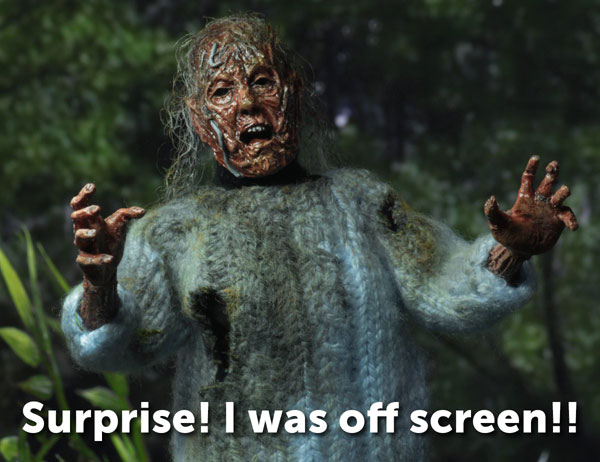What and When?
For some reason, the different initials that can appear after dialogue cues trip up a lot of screenwriters. Let’s have a look at what each one means and when the appropriate time is to use them.
O.S. (Off Screen)
O.S. is used when a character is speaking off screen. Simply put, that means the character is physically at the location in question, but the audience cannot see them on screen at the time they’re speaking.
That means one of two things:
- The character speaking is within the scene but not shown. This option is commonly used when a character sneaks up behind another character and surprises them.
- The character speaking is outside of the immediate location and cannot be seen by the audience or the other characters. This option is commonly used when a character is outside a door, speaking to another character who is on screen.
Use 1 Example:
EXT. CRYSTAL LAKE CEMETERY - NIGHT
Amy rushes from headstone to headstone, her flashlight illuminating each name.
PAMELA (O.S.)
Looking for me?
As she spins around, Amy's eyes rocket wide with fear at the desiccated,
re-animated corpse of Pamela Voorhees.
Use 2 Example:
INT. FRAT ROOM - DAY
A KNOCK at the door. Jefferson freezes, glancing around the room at his new
frat buddies.
JEFFERSON'S MOM (O.S.)
Sweetie, it's Mommy. I have all of
your undies. They're ironed and
folded just the way you like them.
O.C. (Off Camera)
O.C., or off camera, is used in exactly the same way that O.S. is used in the first method I outlined above. The character speaking is physically at the location, but we (the audience) don’t see them in the particular shot used at the time.
So which method do you use? Well, it’s really up to you.
Some writers use O.C. for the first method shown above and use O.S. for the second method shown above. That way there’s never any confusion about where the character is who’s speaking (i.e. visible to characters at the location vs. obscured by a wall, door, boulder, etc.).
However, O.C. is also considered a little bit old fashioned. On top of that, whenever you invoke the term “camera” — even if it’s just in an initial — you’re drawing the reader’s attention to the fact that a production is taking place. There’s a camera and a camera operator and a director, etc. It has the potential to break the fictive spell (the illusion of reality in the reader’s mind).
But that’s really just a quibble. Literally no experienced reader is going to balk at your script because you used O.C. So feel free to use whichever method you prefer.
V.O. (Voice Over)
V.O. is used in situations where the character speaking is not physically at the current scene location. So V.O., or voice over, is used for all telephone conversations, walkie-talkie conversations, radio dispatchers, narrators, television news conversations (if you don’t show us the T.V.), etc.
Example:
INT. POLICE STATION - NIGHT
Detective Benoit answers his ringing phone.
DETECTIVE BENOIT
Benoit speaking.
MYSTERIOUS MAN (V.O.)
Time to play a game. Knock knock,
Detective.
DETECTIVE BENOIT
I'll bite... Who's there?
MYSTERIOUS MAN (V.O.)
(insidious laughter)
Wouldn't you like to know?
DETECTIVE BENOIT
Not really. I'm surprised you're
not more familiar with modern
phone technology, Mr...
(reads call display)
... Jeremy Crocker.
CLICK.
V.O. can also be used like PRE-LAP — at the end of scene — for a conversation that we hear starting before we switch over to the next scene and see the person actually speaking.
Do NOT use O.S. for phone conversations! I see this far too often in the scripts I read.
A few years back, a client sent me an official Oscars-created document offered as a helpful guide to those writers who were submitting to the Nicholl Screenwriting Fellowship competition. The document suggested that O.S. should be used for phone conversations. It literally blew my mind, but it also helped to explain how the misuse of O.S. has propagated so much over time. Always use V.O.
Fortunately, the Oscars have since updated this document and fixed their mistake. However, there are still a bunch of other highly non-standard things in the document, so I’m not going to link to it. Hopefully, they’ll get around to fixing those soon, as well.
Any specific uses of O.S. or V.O. trip you up? Let me know!






Regarding V.O. and O.S. for walkie-talkies, I have a scene in a park where two undercover cops, dressed as homeless folks, lie on separate benches and pretend to be dozing. They’re talking and listening to each other with microphones hidden in their collars and through earpieces. When she hears him speak in her earpiece, I’m at a loss as to which to use. He is “in the scene,” but she and we are hearing him through her earpiece. It will probably be shot with a closeup on her when she’s listening, so I’m thinking O.S. but not sure. Would appreciate your input. Thanks!
Hey Sonja! Great question. If we see the actor who is speaking the line on-camera, you wouldn’t need to use O.S. or V.O.
However, if we’re currently watching a shot where you’re showing someone else, but we’re hearing the off-screen actor through an earpiece, I would definitely use V.O. (even though the person saying the line is just off-screen and technically at the location).
Thanks for your explanation so far. I will I like to have your input on this: what do you use in a situation where by the character in question can be seen on the screen (that is, s/he is in the location and can be seen on camera), but we want to merely project his/her thoughts, or better still, the character is the one narrating the story. Do we use V.O. (or there is another terminology for it in this instance? Many thanks.
Hi Solomon. Great question. Yes, a simple (V.O.) is all you need for those scenarios. Cheers!
Quick question, with walkie talkies it’s essential for the speaker to say “over” so the other person or people know they can speak, but sometimes they don’t and a character’s scary warning is not heard with hilarious consequences. So is it usual to write “over” in the script?
Hey Andy, that’s a good question. When it comes to dialogue, only write what your characters would say. Unless they’re professional military types, I don’t think they have to say “over” each time. And even then, I don’t think it’s required anymore.
wait.. okay, so say I have a scene where a character in in a time past or a split screen and they are in the scene describing it, but not physically speaking at the time that the scene is SHOWING.
Welp. I just saw the Q and A above…. VO it is
Thank you!
Haha. You’re welcome!
Thanks. This helped a lot.
Glad to hear it! You’re very welcome.
Im Still really confused when to use VO and OS
Hi Dhivager, what’s the confusing example you’re contending with in your script?
hey! so i want to write about a man who’s having a conversation with somebody else who is there in the scene but never seen, in reality the man is talking to himself, do i need to us O.S ? and if so, do i have to write another character as the other person he’s talking to?
Hi Daniela, great question! It all depends on what you want the reader to know. If you want them to be surprised later that he’s talking to himself, use O.S. And yes, in this case you’d need a character name, even if it’s just UNSEEN MAN.
If we already know he’s talking to himself, just use V.O. The character name could be something like INNER VOICE or ALTER EGO.
Hope that helps!
Thanks Trevor! You helped me so much!
Do you think I can learn screenwriting alone home through internet?
Thanks again!
Hi Evelyn, you’re very welcome!
And the answer to your question is an enthusiastic YES! There are so many quality resources out there for screenwriters these days. If you’re diligent about vetting your sources, you can find everything you need online and through the odd formatting book or two.
Thanks Trevor for answering me so fast!
I appreciate you encouraged me.
I’m just wondering: I have no one at home to read me the script that I didn’t even write yet because they don’t even speak English.
Would you read it to tell me if it’s good and what errors to fix or not?
As you like, I’m just asking. If you don’t want to or you’re busy, you’re free and I understand that.
P.S: I’m 17.
Thanks again!
Hi Evelyn, I do offer services for ESL writers. Check out my proofreading page and add about 50% to the price. Cheers!
Hi. If the camera is staying on one person but were hearing a conversation between two others outside the room, should O.S. be written after each persons name?
Hi Andrew. Yes, that’s exactly right. You got it! Put (O.S.) after the character names of those not appearing on-screen as they speak but are at the location (or just outside the location).
Hello, what can I use if it’s a documentary showing footage explained by the person interviewed. That is, we hear someone speaking, but that person is not seen on screen.
Hi Amanda, that sounds like a simple (V.O.) usage. Cheers!
What would you use if you have an opening shop of an ext. building, the character inside the building begins talking before we cut to the int. scene of the building. I was using V. O. but I think this might be more of an O. S. situation.
Great question! Your initial instincts were correct. That would be a V.O. shot (because we wouldn’t actually be able to hear him outside of the building).
please trevor i want to writing a scene where the daughter is on a video call with her dad…what should i use?
Hi John Paul, great question!
You would just use (ON COMPUTER VIDEO) or (ON PHONE VIDEO) as the case may be.
I’ll have to do a full post on this in the future.
Why would a writer suggest a pre-lap in his/her screenplay? Isn’t that an directorial/editorial choice?
If you’re on a characters face and we are hearing their thoughts, should you say INTERNAL DIALOGUE, and if so should that be on by the character name or below, in parenthesis?
Hi George! No need to say “(INTERNAL DIALOGUE).” Just “(V.O.)” after their character cue will suffice. We’ll understand that it’s their internal dialogue from the context of the scene.
Hey Paul! Yikes, this comment slipped by me somehow. So sorry about the delayed response!
Great question! A screenwriter might use PRE-LAP, if it adds an element of surprise, humor or character insight, etc. If it’s merely the screenwriter playing editor unnecessarily, I don’t recommend it, but otherwise it’s fair game.
I’m very new to screenwriting. Do you recommend any books, websites or other sources of learning? I just purchased the Final Draft 12 software but still need to learn how to use it. Thanks in advance for any help.
Hi Doug, great question! I’d definitely recommend Blake Snyder’s “Save The Cat.” You also can’t go wrong with Dave Trottier’s “The Screenwriter’s Bible.” Christopher Riley’s “The Hollywood Standard” is also worth a look.
Other than that, I recommend reading scripts from your favorite movies in your preferred genre. Google search will help with that.
John August’s website is also a goldmine for reliable screenwriting advice and insight.
Hey Trevor, I have a question about a situation on whether to use (V.O.) or not and I would rather leave it to you than to the internet which seems to have contradicting answers. I’m reading through and editing my first screenplay, and believe I have formatted correctly up until this point, but I’ve come across a situation where there doesn’t seem to be a clear answer so I thought I’d ask you.
My question is whether or not to use (V.O) for dialogue when it’s via video chat. I have a script that’s heavy on video conferencing. I’ve heard that you use (V.O.) for any and all situations where the speaker is not physically at the location, but that is challenged by others that say you don’t need to bother with (V.O.) if you’ve made it clear the speaker is speaking on a screen. One person went so far as to suggest I use “On Screen” which really pushed my confusion to new heights. So what do you think? In the interest of consistency, should I use (V.O.) for every line of dialogue coming through a screen or leave it out and make it abundantly clear the speaker is on the screen?
Thank you so much for this and your other articles! I have referenced them more than any other while I have been writing this. Your input is invaluable.
Hey John,
Great question! I’ll have to write a new article on this one as I often correct it in scripts.
Some old-schoolers may advise using (V.O.), but that’s only because video conferencing didn’t exist when the standards were being developed. Script formatting rules need to change with the times and in fact have.
I would suggest using (ON VIEWSCREEN) or something similar. It’s perfectly allowable and more accurately reflects the interaction as it’s not simply a voice coming through.
You could also get away with (VIDEO CHAT), (VIDEO SCREEN), (VIA MONITOR), etc.
Hope that helps, and thank you for the kind words!
Hey Trevor, thank you for your insight and the quick reply on the weekend!
One quick follow-up question, should parentheticals always be in all caps?
For example, I have a few moments where under the Character’s name I put: (in Mandarin, subtitles) or (into phone). Should it be (IN MANDARIN, SUBTITLES) or (INTO PHONE)?
Hey John, my pleasure. I love this stuff.
Always use lowercase in parentheticals, except for proper nouns/adjectives as you’ve wisely observed.
Note: Sticklers like myself would use a semicolon, versus a comma, to separate parentheticals (in Madarin; subtitles).
Cheers!
If the character is on screen but also in a video on screen what would you use for the character speaking in the video?
Hey there! You would use (ON VIDEO SCREEN) or (ON PHONE SCREEN). Or simply (VIDEO SCREEN) or (PHONE SCREEN).
These are all formatting devices that have arisen after all of the “rules” were established, so there’s no authoritative answer. Just make sure it’s clear to the reader.
thanks for this, really helpful!
just wondering if there’s a better way to format this:
[Character 1 & Character 2 have been having a conversation in a scene set in location a]
CHARACTER 1
The start of a dialogue line—
FLASH TO:
INT. LOCATION B — DAY (FLASHBACK)
Description of CHARACTER 3, who we only see in the flashback.
CHARACTER 1 (V.O.) (CONT’D)
—dialogue line continues—
Character 3 action description.
CHARACTER 1 (V.O.) (CONT’D)
—dialogue line continues and ends.
BACK TO:
INT. LOCATION A — DAY (BACK TO PRESENT)
CHARACTER 2
Dialogue line responding to what Character 1 has just said.
the main thing that bugs me about this is that character 1’s dialogue sounds like it’s broken up into three separate lines, whereas onscreen it’s meant to be spoken smoothly as one line. but if i make it all one line, the flashback action doesn’t line up… is there a way to make this easier to read?
Hi Lei, thanks!
Readers are accustomed to these types of setups. They’ll read it as a smooth continuation of dialogue. So no worries there.
You should also get rid of FLASH TO and BACK TO. They’re unnecessary as you’ve giving that information in the scene headings. Removing them will also reduce page space and make the dialogue even more connected.
Hey Trevor, me again.
I’m working on a new project where AI dialogue features heavily. I am wondering if I need to use (V.O.) for the AI when it is speaking as its voice is emanating from speakers, even if the physical “housing” of the AI is present in the room. Do I treat it like normal dialogue between characters or should I use (V.O.) every time the AI speaks?
I know this is similar to my last question, but the lack of a video or any physical representation of the AI apart from its voice and housing had me think to reach out again and get some clarification.
Thank you!
Hey John, great to hear from you.
This one’s really easy. Either you use:
A.I. VOICE
or
A.I. (V.O.)
Cheers!
Greetings Trevor,
What is the proper character extension to use when a character speaks inside a fully enclosed vehicle that is on screen, only the vehicle is seen.
Commander
Forward!
I tend to believe (V.O.) is the correct method to use since the charcter is actually on screen but inside the object being filmed.
However, I am not completely sure.
Additionally, the use of (O.C) is never mentioned in “The Hollywwod Standard” by Chris Riley, an amazing book!
Thank you in advance.
Hi Frank, I’d go with O.S. The characters speaking are still in the scene; we just can’t see them. It’s similar to someone talking from behind a door.
Oh and O.C. can be used interchangeably with the preferred O.S., so that’s probably why Chris doesn’t mention it.
Cheers!
Hello Trevor…if a politician is sitting with his advisor watching a speech he gave on television, but the camera is NOT pointed at the tv or the people (but somewhere else in the room, can I use JOHN SMITH (ON TELEVISION) and then when he and his advisor make any comments in the room while watching tv JOHN SMITH (OS) or JANE DOE (OS)? Thank you!
Hey John! Great question. This issue is one that I’m seeing more often in the scripts I’ve been reading lately. I’m going to elevate it to a main post in the future.
Bottom line is, don’t make things difficult for yourself. Just stick with JOHN SMITH and JOHN SMITH (ON TELEVISION) to distinguish the two. Then let the editor sort out who is shown when.
It’s the same as when two people are speaking in the same room —- you don’t have to tell the reader who they’re seeing and who’s offscreen at any given time. The only time you do that is when there’s a reveal of a character that surprises the other.
Cheers!
Thank you very much, for this wonderful answers. Please in a situation a character’s lips
not moving but the audience hears his/her thought what should I use
Another question someone narrating a story using POV and also part of the story what should I use.
Hi Oluchi, the answer to both your questions is to use (V.O.). Cheers!
Quick question. How about a ghost, who is only heard by the main character? V.O. or O.S.?